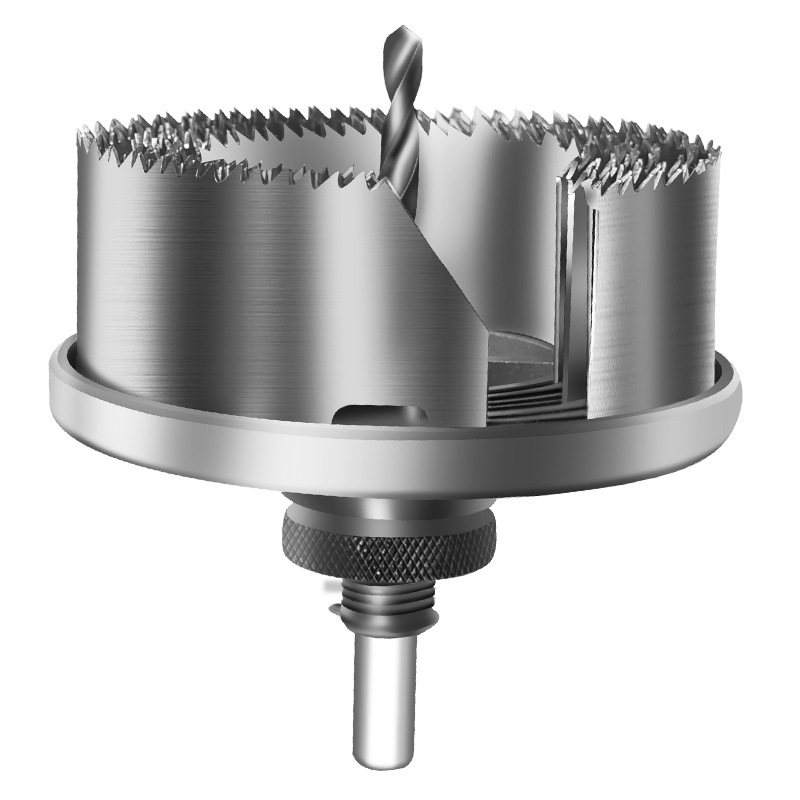Wood Hole Saws: Exploring Features, Technical Details, and Key Advantages
What Are Wood Hole Saws?
A wood hole saw is a cylindrical cutting tool designed to bore large, circular holes in wood and wood-based materials (such as plywood, MDF, and particleboard). Unlike drills, which remove material by chipping away at the surface, hole saws cut along the perimeter of the desired hole, leaving a plug of material inside the saw—this makes them efficient for creating holes of ¾ inch to 6 inches (or larger) in diameter. They attach to drills or drill presses via a mandrel, a central rod that secures the saw and transmits rotational force.
Key Features of Wood Hole Saws
1. Material Construction
The material of a wood hole saw directly influences its durability, cutting speed, and suitability for different tasks:
- High-Speed Steel (HSS): The most common material for general-purpose wood hole saws. HSS is affordable, sharp, and works well for softwoods (like pine and cedar) and occasional use. It can handle moderate heat and is easy to sharpen when dull.
- Bi-Metal: These saws combine a high-speed steel cutting edge with a flexible alloy steel body. The HSS teeth stay sharp longer, while the alloy steel resists bending or breaking—ideal for hardwoods (such as oak and maple) and frequent use. Bi-metal hole saws are also compatible with materials like plastic and thin metal, adding versatility.
- Carbide-Tipped: For heavy-duty applications and extremely hard woods (like teak or rosewood), carbide-tipped hole saws offer superior wear resistance. The carbide teeth retain sharpness even under high heat, making them perfect for professional, high-volume projects.
2. Tooth Design
The arrangement and shape of the teeth determine how cleanly and efficiently the saw cuts:
- Raker Teeth: A pattern with alternating deep and shallow teeth, designed to clear chips quickly. This reduces clogging and prevents overheating, making raker teeth ideal for softwoods and thick materials.
- Pilot Drill: Most hole saws include a small pilot drill at the center. This drill first creates a guide hole, stabilizing the saw and ensuring the hole stays centered—critical for accuracy, especially in large-diameter cuts.
- Tooth Count: Measured in teeth per inch (TPI), a higher TPI (18–24) produces finer, smoother cuts (great for visible holes in furniture), while a lower TPI (10–14) removes material faster (better for rough, hidden holes).
3. Arbor and Mandrel
The arbor (or mandrel) connects the hole saw to the drill. Key features include:
- Shank Size: Most mandrels have a ¼-inch or ⅜-inch shank to fit standard drills, while larger saws may use ½-inch shanks for added stability in high-torque applications.
- Quick-Release Mechanism: Premium mandrels include a quick-release button, allowing users to swap hole saws without tools—saving time when switching between sizes.
Technical Information: How Wood Hole Saws Perform
1. Cutting Speed
- RPM (Rotations Per Minute): Wood hole saws perform best at moderate speeds. For softwoods, 1,500–2,500 RPM is ideal; for hardwoods, slow to 500–1,500 RPM to prevent burning the wood or dulling the teeth.
- Feed Pressure: Apply steady, light pressure. Excessive force can cause the saw to bind, leading to uneven holes or damage to the tool. Let the teeth do the work—letting the saw feed naturally ensures cleaner cuts.
2. Hole Diameter Range
Wood hole saws are available in diameters from ¾ inch (for small wiring holes) up to 12 inches (for large openings like speaker ports). Specialized sets often include multiple sizes, allowing users to tackle a variety of projects with one kit.
3. Depth Capacity
The length of the saw’s cylinder determines how deep a hole it can cut. Standard saws handle 1–2 inches, while deep-cut models (up to 6 inches) are designed for thick materials like wooden beams or cabinetry.
Advantages of Using Quality Wood Hole Saws
1. Efficiency
Hole saws remove only the perimeter of the hole, leaving a solid plug of wood—this uses less energy than drilling out the entire area, saving time and reducing fatigue. They’re significantly faster than using spade bits or jigsaws for large holes.
2. Precision
With a pilot drill and stable design, wood hole saws create round, centered holes with minimal 偏差 (deviation). This is essential for projects like installing door locks, where misaligned holes can ruin the fit.
3. Versatility
While designed for wood, quality hole saws (especially bi-metal and carbide-tipped models) can cut through other materials like plastic, drywall, and thin metal. This makes them a multi-purpose tool in workshops and job sites.
4. Cost-Effectiveness
Compared to specialized hole-cutting tools, hole saws are affordable, especially in sets. A single set can cover a range of diameters, eliminating the need to buy individual tools for each size.
5. Clean Cuts
Sharp teeth and efficient chip removal mean hole saws leave smooth, burr-free edges. This reduces the need for sanding or finishing, saving time in the workflow—critical for professional projects with tight deadlines.
Choosing the Right Wood Hole Saw for Your Project
- Material: HSS for softwoods and DIY use; bi-metal for hardwoods and occasional metal cutting; carbide-tipped for heavy-duty, professional work.
- Hole Size: Select a saw that matches your project’s diameter requirements. Kits are great for versatility, while single sizes work for specific tasks.
- Tooth Design: Raker teeth for chip clearance; high TPI for smooth finishes; ensure the pilot drill is sharp for accuracy.
- Drill Compatibility: Match the mandrel’s shank size to your drill’s chuck (¼-inch or ⅜-inch for most home drills).
Post time: Aug-09-2025
